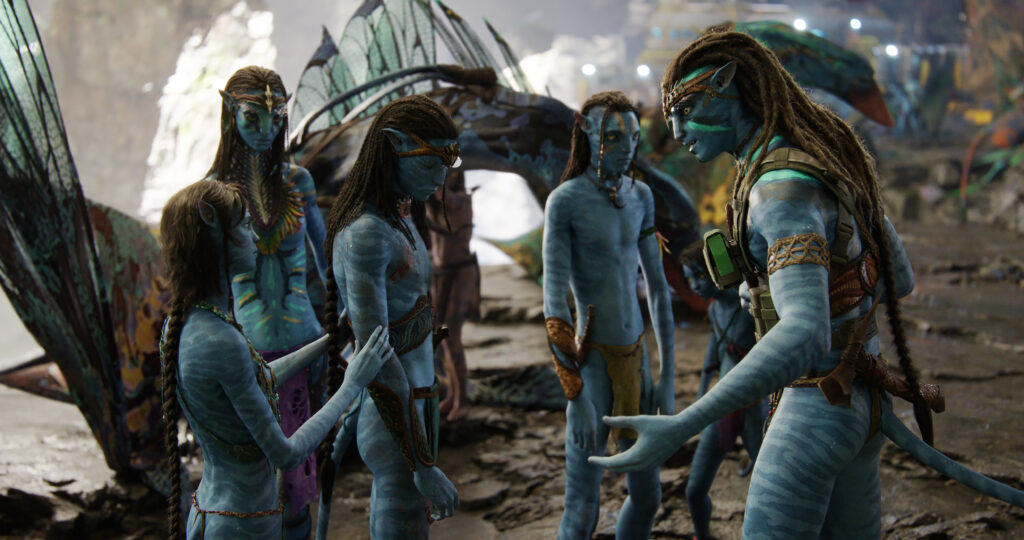December 13, 2022
by Carla Hay

Directed by James Cameron
Culture Representation: Taking place on Earth and on the fictional planet of Pandora, the sci-fi action film “Avatar: The Way of Water” features a predominantly white cast of characters (with some African Americans, Latinos and Asians) portraying humans and non-humans.
Culture Clash: Jake Sully and Neytiri, the heroes of 2009’s “Avatar,” are now the leaders of the Omatikaya clan on Pandora, but Jake becomes the target of revenge for being a traitor to Earth, so he and his family escape to live with another clan on Pandora, with an old enemy in pursuit.
Culture Audience: Besides appealing to the obvious target audience of “Avatar” fans, “Avatar: The Way of Water” will appeal primarily to people interested in watching a top-notch sci-fi film.

“Avatar: The Way of Water” has set the bar even higher for sci-fi epics. The movie’s technical achievements and story surpass the first “Avatar” film. Expect to be immersed in a visually stunning world that has a lot to say about protection of families and the environment. At 192 minutes, “Avatar: The Way of Water” is a more than worth the time of anyone who wants to be entertained for a little more than three hours by a magnificent achievement in sci-fi cinema.
Directed by James Cameron, “Avatar: The Way of Water” is a movie that is fully appreciated if viewers have seen or know about what happened in 2009’s Oscar-winning blockbuster “Avatar,” which was also directed by Cameron. Mild spoiler alert for those who haven’t the first “Avatar” movie, which took place in the year 2154: The movie’s main hero, Jake Sully (played by Sam Worthington), a wheelchair-using U.S. Marine, was assigned to be a bodyguard for Dr. Grace Augustine (played by Sigourney Weaver), the leader of the Avatar Program that gives the ability for humans to appear in the form of something else.
Jake defied the government’s plan for military people to disguise themselves as Pandora natives call the Na’vi, in order to deplete the moon planet of Pandora (located in the Alpha Centauri system) for the precious resource unobtanium. Na’vi people are a humanoid species with blue skin, and the average Na’vi adults are about 10 feet tall. At the end of the first “Avatar” movie, Jake left behind his human life on Earth to become a Na’vi.
At the beginning of “Avatar: The Way of Water” (whose screenplay was written by Cameron, Rick Jaffa and Amanda Silver), it is about 15 years after the first movie took place. Jake (who has fully inhabited his Na’vi body) has been happily married to Neytiri (played by Zoe Saldaña), the female Na’vi who saved his life in the first “Avatar” movie. Jake and Neytiri fell in love in the first “Avatar” movie. They now live on Pandora, where Jake is the leader of the Omatikaya clan, which lives and thrives in the forest.
Jake and Neytiri are now parents to four children: teenage son Neteyam (played by Jamie Flatters) is the “role model” eldest child; teenage son Lo’ak (played by Britain Dalton) is slightly rebellious and living in the shadow of Neteyam; adopted teenage daughter Kiri (played by Weaver) is haunted by the memories of her biological mother; and pre-teen daughter Tuk (played by Trinity Jo-Li Bliss) is friendly and playful. The four Sully kids are very close to a human named Spider (played by Jack Champion), who was orphaned by the war between the Na’vi and humans.
The movie later reveals Spider’s family background and who one of his biological parents is. Spider spends so much time with the Sully kids that he’s almost like part of the family. However, Neytiri is nervous and wary about Spider becoming so close to the kids because she doesn’t completely trust humans, who are called Sky People by the Na’vi. The humans were responsible for nearly destroying Neytiri’s family in the first “Avatar” movie. One of the survivors was Neytiri’s mother Mo’at (played by CCH Pounder), who makes a brief appearance in “Avatar: The Way of Water.”
Kiri’s origins are revealed near the beginning of the movie: She was created from the DNA of Dr. Augustine. Mild spoiler alert for those who don’t know what happened in the first “Avatar” movie: Dr. Augustine died in the first “Avatar” movie, but she makes an appearance in flashbacks in “Avatar: The Way of Water.” Throughout the movie, Kiri feels a psychic connection to that is both confusing and comforting to Kiri.
In the first “Avatar” movie, the U.S. government’s Resources Development Administration (RDA) was in charge of raiding Pandora for unobtanium because resources on Earth have diminished. The RDA still exists in “Avatar: The Way of Water,” and they consider Jake to be a traitorous enemy because of what happened in the first “Avatar” movie. As described in the “Avatar: The Way of Water” production notes: “In addition to having an armada of weaponized land, air and sea vehicles at their disposal, the RDA has brought with them a secret weapon: an elite team of soldiers resurrected as recombinants (recoms). Recoms are autonomous avatars embedded with the memories of the humans whose DNA was used to create them.”
This group of recom soldiers has been tasked with one primary mission: find and kill Jake. The leader of this mission is Recom Colonel Miles Quaritch (played by Stephen Lang), the avatar of the human Colonel Miles Quaritch (also played by Lang), who was head of RDA’s security force and Jake’s biggest adversary in the first “Avatar” movie. During this mission, the recom soldiers appear in the form of Na’vi when they go to Pandora to hunt down Jake.
Through a series of circumstances, the Sully family is are forced to leave their home. They flee to another part of Pandora, where they are taken in as refugees by the green-skinned Metkayina clan. Whereas the forest is the primary domain of the Omatikaya clan, the ocean is the primary domain of the Metkayina clan, which reluctantly lets the Sully family live with them because it’s a Na’vi tradition to help refugees of Pandora.
The leaders of the Metkayina clan are upstanding and fair-minded Tonowari (Cliff Curtis). and his compassionate wife Ronal (played by Kate Winslet), who is pregnant when this story takes place. Ronal and Tonowari tell their teenage children—daughter Tsireya (played by Bailey Bass) and older son Aonung (played by Filip Geljo)—to attempt to teach the Sully kids how to adapt to the clan’s water activities, customs and traditions. Aonung is somewhat hostile to these newcomers, while Tsireya is welcoming.
Tsireya and Lo’ak have an immediate “attraction at first sight” the first time that they meet each other. It leads to some romantic moments but also some tensions, particularly from Aonung, who clashes with and bullies Lo’ak during much of the story. The residents of Pandora have much bigger problems though, when Recom Colonel Miles Quaritch and his marauding team of soldiers invade Pandora in their hunt for Jake.
“Avatar: The Way of Water” has some of the most eye-popping and gorgeous visuals (especially the underwater scenes) that movie audiences will ever see in a sci-fi movie. In addition to the movie’s visual effects, “Avatar: The Way of Water’s” enchanting cinematography and production design are particularly noteworthy. “Avatar: The Way of Water” also has emotionally impactful stories about the connections that humans and humanoids can develop with other animals. And just like in the first “Avatar” movie, “Avatar: The Way of Water” has a very pro-environment message that isn’t preachy but is presented in a way that serves as a warning of what could happen when a planet’s inhabitants don’t take care of their planet.
The majority of the cast members in “Avatar: The Way of Water” do not appear in human form, due to visual effects, so their acting is on par with similar big-budget movies that use visual effects to alter the appearance of the cast members. However, Weaver (as Kiri) and Dalton have some standout moments as children who feel like misfits in their family and who feel like they have something to prove about their worth in their family. Champion’s portrayal of Spider is also admirable, because Spider goes through his own issues dealing with self-esteem, identity and family loyalty.
Other characters in “Avatar: The Way of Water” include General Ardmore (played by Edie Falco), a ruthless official from RDA; Captain Mick Scoresby (played by Brendan Cowell) and Dr. Ian Garvin (played by Jemaine Clement), who are recruited by RDA to help track down Jake and find more unobtanium; and scientists Dr. Norm Spellman (played by Joel David Moore) and Dr. Max Patel (played by Dileep Rao), who were allies to Jake in the first “Avatar” movie.
The “Avatar” universe is best experienced from the beginning to fully understand the nuances and developments of “Avatar: The Way of Water” and other “Avatar” sequels. “Avatar: The Way of Water” is a movie that has Oscar-worthy technical prowess, but the dialogue is a little on the simplistic and generic side. What the movie lacks in dazzling dialogue it more than makes up for in delivering a poignant, thrilling and entertaining story with a big heart that viewers will want to revisit.
20th Century Studios will release “Avatar: The Way of Water” in U.S. cinemas on December 16, 2022.




